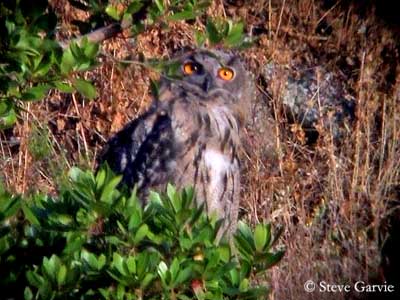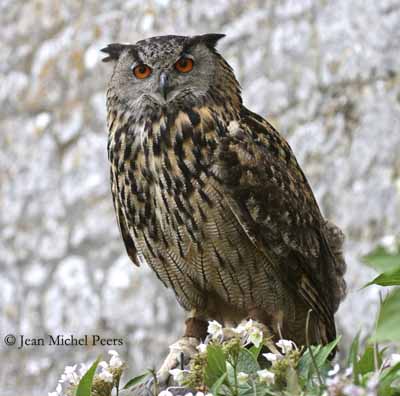
Eurasian Eagle-owl
Bubo bubo
Strigiforme Order – Strigidae Family
BIOMETRICS:
Length: 60-75 cm
Wingspan: 160-188 cm
Weight: M: 1500-2800 g – F: 1750-4200 g
LONGEVITY: From 21 years in wild, up to 60 years in captivity.
DESCRIPTION:
Eurasian Eagle-owl is a large-sized owl, able to kill and carry preys of 200 to 2000 grams.
PROTECTION / THREATS / STATUS:
The Eurasian Eagle-owl has suffered numerous declines last century due mainly to human persecution, effects of myxomatosis on rabbit populations, poisoning, collisions with vehicles and wires.
Protection programs and reintroduction in several parts of the range, increased food supply with rats at refuse tips, are important factors in the fairly rapid post-1970 recovery.
This species is scarce or uncommon, even rare throughout the range.
But at this moment, the species is evaluated as Least Concern by Birdlife International.
Fr: Grand-duc d’Europe
All : Uhu
Esp: Búho Real
Ital: Gufo reale
Nd: Oehoe
Russe: Филин
Sd: Berguv
Photographers:
Didier Buysse
Vision d’Oiseaux
Steve Garvie
RAINBIRDER Photo galleries
Tom Merigan
Tom Merigan’s Photo Galleries
Niraj V. Mistry
Photo Galleries
Jean Michel Peers
JMPN PHOTOGRAPHIE
Text by Nicole Bouglouan
Sources:
HANDBOOK OF THE BIRDS OF THE WORLD Vol 5 by Josep del Hoyo-Andrew Elliott-Jordi Sargatal - Lynx Edicions - ISBN: 8487334253
THE HANDBOOK OF BIRD IDENTIFICATION FOR EUROPE AND THE WESTERN PALEARCTIC by Mark Beaman, Steve Madge - C.Helm - ISBN: 0713639601
L’ENCYCLOPEDIE MONDIALE DES OISEAUX - Dr Christopher M. Perrins - BORDAS - ISBN: 2040185607
BIRDS OF THE MIDDLE EAST by R.F. Porter, S. Christensen, P Schiermacker-Ansen C.Helm - ISBN: 0713670169
BirdLife International (BirdLife International)

It has brown-black and buff upperparts, with a cloud of spots on forehead and crown, stripes on nape, neck sides are rear neck, and black mottling on pale back, mantel and scapulars. Rump and tail bear fine black vermiculations.
A narrow, pale buff band with brown spots runs from the bill base up to the lores and along the brown-black edge of the moving ear-tufts.
The facial disc is dark buff, heavily speckled brown-black on the outer edge, forming as a frame around the face. Chin and throat are white, ending in the middle of the upper breast.
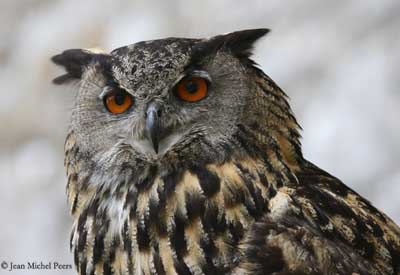
Underparts are dark buff finely marked with black vermiculations. The black spots are broader on breast than on belly.
The buffy-white legs are well feathered and show the same pattern but lighter. Tail is dark buff, speckled black, grey and brown, with about six brown-black bars. Bill and talons are black. Eyes are deep orange or golden.
Both sexes are similar in plumage with female larger than male.
Juvenile is covered in buffy down, finely barred on wings, uppertail coverts and underparts.
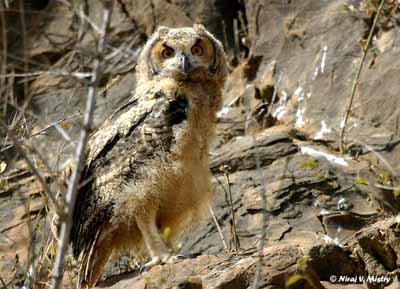
We find 14 recognized subspecies. They differ in colour and intensity of dark marks, and in size.
VOICE: SOUNDS BY XENO-CANTO
Eurasian Eagle-owl utters deep and monotonous « oohu-oohu-oohu » repeated every 10 seconds as territorial call. The female’s call is slightly higher-pitched and more raucous than male’s. Both mates perform duets during courtship displays.
When alarmed and threatened, they may “bark” and grunt, and give harsh “ka ka kau”.
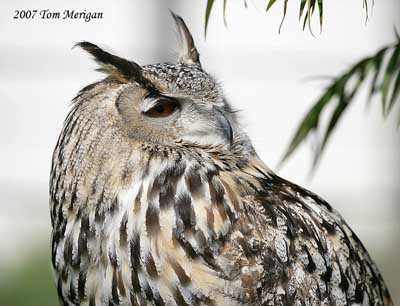
HABITAT:
Eurasian Eagle-owl frequents some variety of habitats, from conifer forests to warm deserts. It favours the undisturbed rocky areas with cliffs, ravines and caves, scattered trees and thickets.
It also can be found in taiga, open forests, wooded steppes, quarries and cultivated areas in rocky places.
This species breeds from sea-level up to 2000 metres of elevation in Europe, and between 4200 and 4500 metres in C Asia and the Himalayas.
RANGE:
North Africa, Europe, Asia and Middle East.
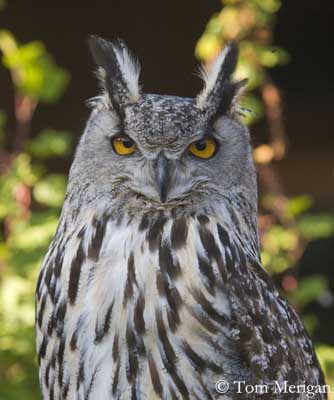
BEHAVIOUR:
Eurasian Eagle-owl has several hunting methods, and may catch a prey on the ground from an exposed perch, or in the air after searching flight.
It attacks the prey by surprise while flying low from the ground or above the treetops. It may capture sleeping birds in rocky crevices. It is able to catch a fish after an Osprey-like dive into water.
It hunts mainly in forest, but prefers open areas.
This species is active mainly at dusk and dawn, but also by day in summer in the northern parts of the range.
The non digestible parts of the preys are ejected in pellets of about 75 x 32 mm of size.
Eurasian Eagle-owl is territorial, but the closest territories may partially overlap without any problem.
Often pairs remain together for life.
When the breeding season starts, the male suggests some nesting places to the female, while scraping for shallow depression and uttering clucking and staccato sounds.
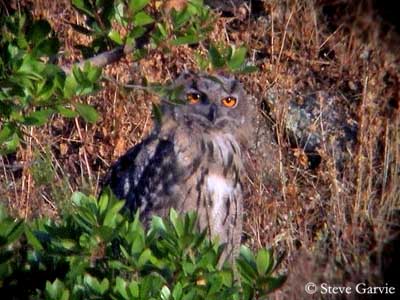
The favourite nest-sites are sheltered by rocky wall, crevice or cave in cliffs. They also use abandoned nests of large birds. If they do not find any suitable place, they may nest on the ground between rocks, below fallen trees, bushes, or at base of tree trunk. Any addition of material.
Often several depressions are proposed to the female. She chooses one which will be reused for several years.
Eurasian Eagle-owl is resident in most parts of the range, but juveniles may disperse after the nesting period. Some movements are recorded in winter, according to the food resources or in harsh weather conditions.
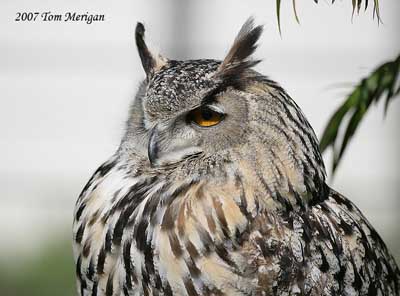
FLIGHT:
During the breeding season, the Eurasian Eagle-owl rises into the sky at dusk and soars at good height.
It has agile and silent flight in spite of its large size, comfortable on its large wings, with head and short tail well separated from the body.
It often appears as a ghost while flying before the moon or in some light.
REPRODUCTION:
Breeding season varies with the range.
The nest of the Eurasian Eagle-owl is often on sheltered cliff ledge or in crevice, in cave, on the ground on steep slope or in abandoned nest in tree.
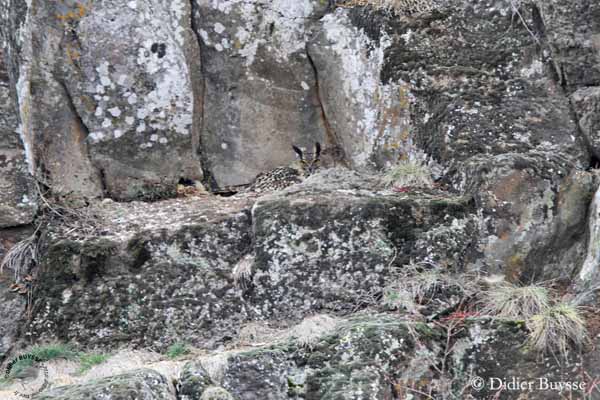
Laying usually starts at the end of winter, sometimes later, and there is only one brood per year. Female lays 1-4 eggs at three days intervals. Incubation lasts about 31-36 days by female and starts with the first egg laid. The male feeds her at nest during this period.
Chicks are brooded by female for the first two weeks, and she remains at nest with them for about 4-5 weeks.
During the first 2-3 weeks, the male carries the food at nest or close to it, and the female feeds the youngs with pieces of flesh. At 3 weeks of age, youngs begin to feed themselves, swallowing small bits whole. At 5 weeks, they walk around the nest and at 52 days, they are able to fly over some metres.
If they can leave the nest when on the ground at 22-25 days, they cannot leave a higher nest before 5-7 weeks.
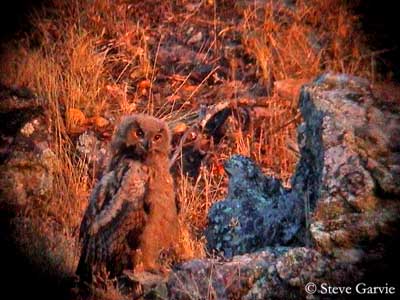
They are fed by both parents during 20-24 weeks. They become independent between September and November, and leave the parental territory, or are “pushed out” by adults.
At the same moment, the male selects several places for the future nesting period.
Youngs reach their sexual maturity the next year, but they do not breed before 2-3 years.
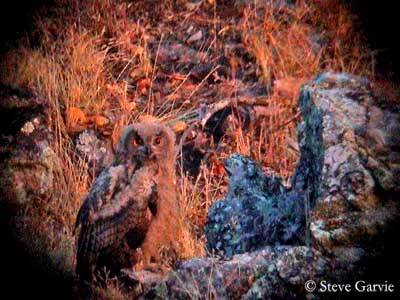
DIET:
The Eurasian Eagle-owl feeds on all moving animals, from beetles to fawns. The most part of its diet includes mammals such as voles, rats, mice, foxes and hares, but also birds of all species, crows, waterfowls, seabirds, and even other raptors’ species. It also may consume snakes, lizards, amphibians, fishes and crustaceans.
